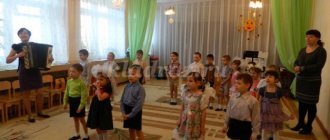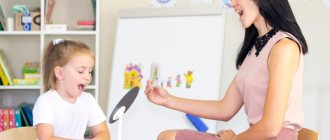Organization of a speech therapy corner in a group of combined and compensatory orientation
The effectiveness of correctional and developmental work with children with SLD largely depends on the interaction between the speech therapist and other specialists. And, above all, speech therapists and educators. In the evening, teachers consolidate the skills acquired by children on the instructions of the speech therapist. In order for correctional work to be successful, this must be done and not only the speech therapist is responsible for correctional work, the main assistants are educators and parents.
The teacher-speech therapist interacts with teachers in various forms: consultations, conversations, interaction notebook/
The teacher conducts classes in the speech therapy corner in the afternoon on the instructions of the speech therapist. Children, together with the teacher, do articulation and breathing exercises. Children practice articulation of sounds and automation in words using object pictures. Sentences and short stories are made up with these words, and games are made to differentiate the given sounds. Work is underway to expand vocabulary, grammatical structure and coherent speech. To carry out high-quality work, it is necessary that the speech corners be filled with practical material and function!
The speech corner in the group should include the following sections:
- articulatory motor skills : (mirror, card index, pictures for articulation exercises, sets of exercises for certain groups of sounds).
- automation of sounds : albums on automation of sounds V.V. Konovalenko, S.V. Konovalenko; game exercises L.A. Komarova; didactic manuals Spivak, Egorova, tongue twisters, card indexes.
- breathing : card indexes, turntables, pipes, balloons for inflation, bubbles, soap bubbles, pillows, exercise equipment for breathing development, disposable straws, games with water (grow foam, storm in a glass, boats), football with an air stream, “snake tongue” and so on.;
- phonemic hearing : musical toys, noisy boxes, card index of games.
- vocabulary : pictures reflecting the lexical topic being studied (plot and subject); educational puzzles, games: lotto, “Pick a Pair”, “Who Can Name More”, “Part and Whole”, children’s “Professions”, “all year round”, “family”, “trees”, etc.; game file.
- grammatical structure of speech : didactic manuals by N.E. Teremkova, N.S. Ruslanova, Z. Agranovich, Kosinova E.M., card index of games
- coherent speech : plot pictures, diagrams of descriptive stories, series of pictures, mnemonics, texts for retelling, Arbekova’s manuals by age
- literacy : word diagrams, sentence diagrams, a manual for sound analysis of words, traffic lights, simple puzzles, isographs, etc. manual by Z. Agranovich
- fine motor skills : small toys, tops, lacing, mosaics, puzzles, stencils for shading, internal and external tracing, pencils, etc.;
- higher mental functions : cut pictures, dominoes, “The fourth odd one”, “Color and shape”, “Recognize by contour”, etc...
I wish you success!
Zaitseva Lyubov Viktorovna teacher-speech therapist, MODU "Kindergarten No. 211", Yaroslavl
Interaction between a speech therapist teacher and parents through the design of the “Speech Pathologist’s Corner” stand.
Publications on the topic:
Interaction between a teacher-psychologist and a teacher-speech therapist in creating a comfortable environment in teaching children with disabilities in an educational institution. Teacher-psychologist: Radosteva T. A. Teacher-speech therapist: Galkina N. V. MBDOU “Kindergarten No. 14 “Firefly”, Kudymkar ( 2016) 1. Good afternoon.
Interaction between a teacher-speech therapist and a teacher-psychologist in correctional and developmental classes. Teacher-psychologist Migunova E. V. Teacher-speech therapist Krasilova S. M. The modern educational process is not possible without the interaction of specialists.
Work experience of a speech therapist teacher “Innovative methods and techniques in the work of a speech therapist teacher at a preschool educational institution” Slide No. 1 Natalya Valerievna Popova, speech therapist teacher, kindergarten No. 40 “Brigantina”, o. Balashikha. Slide No. 2 Dear jury, dear ones.
Project “Interaction between a teacher-speech therapist and specialists in supporting children with speech disorders in preschool educational institutions” PROJECT PROGRAM Problem Difficulties in the coordination of correctional and developmental work of all specialists in preschool educational institutions. Project goal: Development.
Project Interaction between a speech therapist teacher and parents of children of senior preschool age with special needs development disorders in the process of correctional work.
Message from work experience “Interaction between a speech therapist and a teacher in working with children in a speech therapy group.” I work as a teacher in a speech therapy group, the work of our group is based on close contact with the speech therapist teacher. In my work.
Interaction between educators and a speech therapist teacher in project activities in a compensatory group “Interaction between educators and a speech therapist teacher in project activities in a compensatory group for children with disabilities.
Interaction between a teacher-psychologist and a speech therapist in working with preschool children Dear colleagues, modern life does not stand still, a lot is changing, new technologies are appearing. This is our Russian education system.
Interaction between a speech therapist and parents Slide 2 In recent years, the number of children encountering various learning difficulties in primary school has increased significantly. The most.
Interaction between a teacher and a speech therapist on the prevention of speech underdevelopment in preschool children Currently, the number of children with speech disorders is increasing. Therefore, the need to prevent speech disorders is increasing.
Materials for speech therapy corner
The school has a speech center. A speech therapist teacher conducts individual and subgroup classes with children in the following areas:• General speech underdevelopment
• Violation of sound pronunciation
• Phonemic hearing disorders
Unfortunately, nowadays, quite often, parents retain the illusion of the possibility of a magical, magical resolution of all problems in the development and upbringing of a child only as a result of attending correctional classes. Whatever significant positive changes in a child’s speech occur during classes with a speech therapist, they acquire significance only if they are transferred to a real life situation. No positive dynamics during correctional speech therapy can lead to the achievement of the expected effect if changes in the child’s speech development do not find understanding, response, or appreciation from parents, if significant, authoritative, beloved loved ones do not see the true meaning of these changes.
Work on the correction of speech disorders and the formation of correct speech in schoolchildren, which fully performs the communicative function, cannot be limited to the speech therapy room. It is effective only if the knowledge and skills acquired by children in speech therapy classes are reinforced not only by school staff, but also by the child’s parents. The relationship between the work of a speech therapist and the family makes it possible to correct speech deficiencies much faster: automate sounds, form the necessary lexical and grammatical structures, accumulate vocabulary and help develop coherent speech.
The success of speech therapy work is possible if parents fulfill a number of requirements:
When communicating with a child, you should speak grammatically correct and expressively. Remember, your speech is a model for your child.
At the stage of automation of the sound set by the speech therapist, it is the responsibility of the parents to listen carefully to the speech of the children: how the child uses the sounds set in the game, in a conversation with other children, in a conversation with you. Do not ignore a single incorrectly pronounced sound, word, or sentence.
Carry out systematic monitoring not only of the sounds given, but also to ensure that the children’s speech is grammatically correct.
Do not skip speech therapy classes. Unreasonable absences from classes interrupt correction, and often the speech therapist has to start work all over again.
Do your speech therapist's homework on automating and differentiating sounds, reinforcing lexical and grammatical topics, developing coherent speech, preparing your hand for writing, and teaching literacy.
Teach your child and yourself to practice with him every day, at least for 15-20 minutes. Some exercises can be performed on the way to the store or in transport; you can ask the child questions and tasks during daily housework, that is, in everyday life. Don’t waste your time on studying, it will pay off many times over later!
You should not express doubts in the presence of a child about the reality of correcting his speech. You always need to instill faith in success.
Encourage every small improvement in your child's speech.
Teach your child to give complete, detailed answers to questions posed to him. Help him formulate his own statements, ask precise questions, encouraging the child to speak.
Dear parents, remember, only your joint work with a speech therapist is an integral part of the entire correctional pedagogical process and it is difficult to overestimate it!
Methodological guide for designing a speech corner in a speech therapy group
Tatiana Karas
Methodological guide for designing a speech corner in a speech therapy group
The problem of speech in all its species diversity is relevant in preschool age. Today, there are many techniques that can be used to regulate the process of speech development in children. The most important condition for improving the speech activity of preschoolers is the creation of an emotionally favorable situation that promotes the desire to actively participate in verbal communication . At the same time, play communication between children is of particular importance. Playful communication is the necessary basis within which the formation and improvement of a child’s speech activity .
The development of a preschool child is greatly influenced by the space around him, the environment in which he spends most of the time. In a preschool setting, such an environment is a group room . The problem of organizing a subject-developmental environment acquires particular significance when working in speech therapy groups . Unregulated educational activities of children directly (under the guidance of a teacher or independently)
the longest.
During this activity, educators organize individual and subgroup correction-oriented forms of interaction with children. A subject-based developmental environment makes it possible to enrich the experience of a child’s emotional and practical interaction with peers and the teacher, and to include all children in the group . The environment stimulates the development of cognition and initiative. In it, children realize their abilities .
The subject development environment includes a correctional corner in the group . It is a specially equipped space for playing alone or in small groups . Its equipment includes shelving, a mirror, gaming, didactic and visual material. With their help, educators create conditions for correcting deviations in the development of children, stimulating speech activity and verbal communication . The filling of the correctional corner is based on thematic planning on lexical topics. The selection of gaming and didactic material is carried out on the basis of the recommendations of a speech therapist , which makes interaction with teachers not formal, but very close and fruitful. The content is determined not by chance, but in strict accordance with the program, physiological and psychological-pedagogical features of speech formation.
Didactic equipment must correspond to the structure of children’s speech disorders , their individual and age characteristics. Only with this approach is it possible to effectively correct the speech of preschool children. With a random, formal selection of games, children’s perception volume is overloaded and learning ability is sharply reduced.
Game and didactic material is replaced or replenished in the correctional corner weekly , depending on the lexical topic.
It is necessary to diversify the activities of children in the correctional corner . Didactic equipment must meet the needs of the child’s current, immediate development and self-development. A subject space that is empty in content tires and encourages idleness and aggression. At the same time, you should not overload the corner with equipment , as this makes selection difficult. The material contained in the correction corner is multifunctional. Games should be selected in order of increasing complexity, aimed at the development and correction of speech, the development of phonemic perception, pronunciation skills, auditory attention, verbal memory, articulatory motor skills, games that provide compensation for higher mental functions and constitute the psychological basis of speech.
The more complex and varied the activity, the more necessary speech is, the greater the need for communication. All material must be age appropriate for children. Relying on play as the leading activity of preschoolers provides a significant positive effect in correctional work. The game creates conditions for informal communication between the child and peers and adults, and provides him with complete freedom of action. Therefore, the game material must be accessible to him. This has a positive effect on speech development and intellectual development in general. Compiling gaming and didactic material in the correctional corner on lexical topics presupposes systematic work. It is regulated by educators in accordance with the sections of the program or the corrective tasks being solved.
group development environment , it is very important that the environment surrounding the children is comfortable and aesthetically pleasing. Beauty shapes a child. Therefore, it is necessary to pay great attention to the aesthetics of the correction corner . Its design should be attractive to children and arouse their desire for independent activity. At the same time, it is necessary to teach children to maintain order in the corner and cultivate a caring attitude towards toys.
to locate the correction corner in a well-lit place and somewhat distant from the playing area. This will create more comfortable conditions for studying there. Access to the corner should be convenient so that children can approach it themselves and study. If there is insufficient lighting, additional lighting must be provided. The proximity of the play area will interfere with activities in the corner and distract the child from completing tasks.
The filling of the correction corner should be carried out according to the following sections:
•articulation gymnastics in pictures: (pictures for articulation exercises, sets of exercises for articulation in pictures-tables). You can make this yourself, and take the description from methodological literature . For example: T. A. Kulikovskaya “Articulatory gymnastics in poetry and pictures”
,
“Articulation gymnastics in counting rhymes”
, V. V. Konovalenko, S. V. Konovalenko “Articulation, finger gymnastics and breathing-voice exercises”;
•fine motor skills: tops, dry pool, lacing, mosaics, puzzles, stencils for shading, internal and external tracing, pencils, etc.;
•breathing: pinwheels, pipes, balloons, bubbles, air-stream games, etc.;
•higher mental functions: cut-out pictures, dominoes, “The fourth odd one”
,
“Color and Shape”
,
“Find out by contour”,
etc... It is advisable to discuss the content of this section with
a psychologist ;
• phonemic hearing: games for differentiating sounds - for example, Games with paired cards by Z. T. Bobyleva;
•sound pronunciation: albums on sound automation V. V. Konovalenko, S. V. Konovalenko; game exercises by L. A. Komarova; games for automation of sounds: “ Speech therapy lotto ”
,
“
Speech therapy domino ” ,
“Steam locomotive”
,
“Pick up and name”
, etc.);
•vocabulary: pictures reflecting the lexical topic being studied (plot and subject)
;
educational puzzles, games: lotto, “Pick a Pair”
,
“Who Can Name More”
,
“Part and Whole”
, etc.;
•grammatical structure of speech: games by E. M. Karpova, E. V. Solovyova, V. V. Konovalenko, S. V. Konovalenko, the game “Whose tail?”
,
“One is many”
,
“Call me affectionately”
,
“What’s missing?”
and etc. ;
•coherent speech: plot pictures, “Guess by the description”
,
“When does this happen?”
,
“Playing in the profession”,
etc.;
• literacy: diagrams of words, sentences, games: “Match the word to the diagram”
,
“Make a sentence according to the diagram”
,
“Add a word”
, crosswords, puzzles, etc.
A toy occupies a special place in a child’s objective world. She is a friend, a partner in the world of games, an interlocutor. Puppet therapy allows you to solve such important correctional problems as overcoming uncertainty, shyness, achieving emotional stability and self-regulation. Therefore, a toy can be made the key character of the correctional corner . Such a toy should be multifunctional. This is definitely an animated character. Its ability to move (with the help of an adult or child , ask questions or answer them, ask riddles, come up with interesting stories, invite friends to visit, present unexpected surprises arouses keen interest in children, encourages speech activity . The toy may have a bright movable tongue , with the help of which it is easy to explain articulatory gymnastics exercises to children. Her clothing may contain various elements for the development of fine motor skills of the hands (buttons, hooks, buttons, laces, Velcro, buckles, zippers, clips, etc.). The fabric from which it is sewn clothes can be different, which allows children to easily learn the names of materials, as well as characterize their properties (using tactile sensations)
. The color scheme helps you remember the primary colors. If a character has movable arms or legs, then with their help children quickly master orientation in the body diagram.
classes in the speech therapy corner in the afternoon on the instructions of the speech therapist . Children practice articulation of sounds and automation in words using object pictures. Sentences and short stories are made up with these words.
with a group of children to differentiate sounds or expand vocabulary.
Children themselves come to the speech therapy corner : do gymnastics for the tongue, blow in games to develop an air stream, take outlines, lacing, mosaics, puzzles, name pictures in sound albums, play speech therapist .
One of the main conditions for the quality of correctional speech intervention is the teacher’s sincere interest in its results, the desire to help the child, and constant readiness to provide him with the necessary help and support in cases of difficulty. If the adult wants it, the child will want it too
Thus, the use of a correctional corner allows you to expand the speech environment in the group , create in children emotional responsiveness and a desire to participate in verbal communication with adults and independently, during the game, easily and naturally develop and improve their speech skills .
The information equipment of the speech therapist's corner for parents includes several sections:
— expansion of vocabulary, enrichment of the active vocabulary.
For each lexical topic, an approximate vocabulary for the entire week is indicated, a circle of words is outlined that all specialists and parents, under the guidance of a speech therapist, will introduce into the active speech of children. This ensures the quickest actualization of new words for children.
— formation of lexical and grammatical means of language and development of coherent speech: lexical and grammatical games and exercises.
— development of fine and gross motor skills, coordination of speech with movement: finger and articulation gymnastics, outdoor games.
— development of phonemic, phonemic analysis and synthesis of words, phonemic representations;
— improvement of spatio-temporal orientations;
— development of constructive praxis;
- development of thinking, memory, attention.
Practice using the information block for parents on lexical topics.
The problem of organizing correctional work to overcome speech impairment in preschool children (5-6 years old) with such a type of speech pathology as underdevelopment of the lexico-grammatical structure is relevant, in our opinion, because lexico-grammatical operations for generating speech are extremely complex and involve a fairly high level of development of analytical and synthetic activities.
To increase the effectiveness of correctional influence, we consider the need for integrated work in the interaction of all subjects of educational activity: speech therapists, educators, parents, physical education instructor, music director, art teacher.
An integrated approach to overcoming a speech defect involves the active participation of parents, who consolidate all the speech skills and abilities of children acquired in kindergarten in everyday life.
The purpose of the pedagogical experience: to create in kindergarten the necessary information block of complex correctional work to overcome lexical and grammatical speech disorders in preschool children (5-6 years old).
This system of work has been used in the work of speech therapists at the MADOU “Kindergarten No. 395” of the city of Perm A. F. Buzmakova, E. G. Bugrova for 15 years, has a positive expert opinion from Art. Researcher at the Laboratory of Special Education of PKIPKRO E. E. Ayupova.






